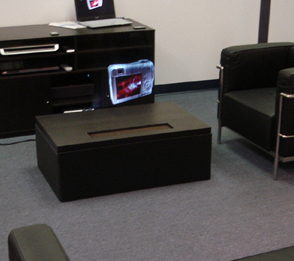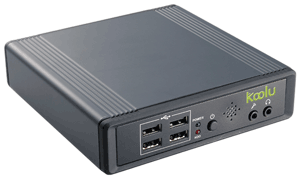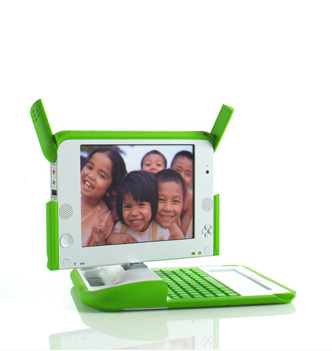|
Tech Watch seeks to monitor developers, researchers, standards agencies, and manufacturers of mainstream technologies and to work to bring those technologies that have importance to AAC and AT devices.
|
|
New Uses for Technology
Wiimotes - Remote game controller for the Nintendo Wii
- 3 axis accellerometer
- high resoultion IR camera
- 4 point IR/LED tracking
- Integrated speak and vibrator
- Wireless connectivity through bleutooth
|
Johnny Lee's Wiimote Project Page
Johnny Lee Sample Projects:
Finger Tracking with the Wiimote
Using an LED array and some reflective tape, you can use the infrared camera in the Wii remote to track objects, like your fingers, in 2D space. This lets you interact with your computer simply by waving your hands in the air similar to the interaction seen in the movie "Minority Report". The Wiimote can track upto 4 points simultaneously. The multipoint grid software is a custom C# DirectX program.
|
|
Low-Cost Multi-point Smartboard(r) Using the Wiimote
Since the Wiimote can track sources of infrared (IR) light, you can track pens that have an IR led in the tip. By pointing a wiimote at a projection screen or LCD display, you can create very low-cost interactive whiteboards or tablet displays. Since the Wiimote can track upto 4 points, up to 4 pens can be used. It also works great with rear-projected displays.
|
Head Tracking for Desktop VR Displays using the Wii Remote
Using the infrared camera in the Wii remote and a head mounted sensor bar (two IR LEDs), you can accurately track the location of your head and render view dependent images on the screen. This effectively transforms your display into a portal to a virtual environment. The display properly reacts to head and body movement as if it were a real window creating a realistic illusion of depth and space.
|
HelioDisplay - The M30 Heliodisplay multimedia projector supports up to a 30"(76cm) viewable diagonal free-space image and includes a supplied projection system so that no additional hardware is required. The M30 is only 5.9" tall. 
http://www.io2technology.com/technology/images |
|
New Hardware
fit-PC – the 5W paperback-sized PC. fit-PC is a tiny, noiseless, extremely power-efficient PC - designed by CompuLab - one of the leading vendors in embedded computing. fit-PC is designed to fit where a standard PC is too bulky, noisy and power-consuming. 
|
The Koolu Appliance is a quiet, space saving, multi media capable computing device. The combination of Google Apps, Ubuntu Desktop and Koolu Appliances save companies money by reducing inefficiencies and increasing productivity while being friendly to the Environment. |
XO-1 - previously known as the $100 Laptop or Children's Machine, is an inexpensive laptop computer intended to be distributed to children in developing countries around the world. The laptop is developed by the One Laptop per Child (OLPC) social welfare organization, and manufactured by the Taiwanese computer company, Quanta. Built to be rugged, the low-power computers contain flash memory instead of a hard drive and use Linux as their operating system. Mobile ad-hoc networking thru mesh networking is used to allow many machines to share Internet access from one connection.  |
|
Open Source OS and Apps
Android Open Source Phone Platform from Google
Try Linux without reformatting your comuter. Using ubuntu Live CDs you can boot up your PC with a temporary version of Linux that goes away when you reboot.
|
|
Next generation speech synthesis: We are monitoring products with improved naturalness into AAC technology. Several mainstream commercial companies including AT&T, Lucent Technologies, ScanSoft and Loquendo, are working towards the development of next generation text to speech synthesis. Our goal will be to evaluate the process of these efforts and disseminate this information to the AAC industry.
Interactive Demos – you type, it speaks:
Non-Interactive Demos:
Multimodal Speech Demonstrations:
Open Source TTS Efforts:
Operating Systems:
- Vista Speech:
- Linux Free Speech:
- Mac OS X: VoiceOver is a fully integrated, built-in screen reader technology providing access to the Macintosh through speech, audible cues and keyboard navigation.
Personalization of synthesized voices: We are monitoring the work of the AT&T Natural Voices group which has made tremendous advancements in natural and personalized voices. AT&T has introduced a customizable version of their text to speech engine (http://www.research.att.com). In collaboration with our Federal Lab Consortium partners who have a relationship with AT&T, we intend to continue to track developments.
Speech Recognition:
Open-Source Speech Recognition Initiative (OSSRI) a new project that intends to "... develop continuous-speech recognition software with command-and-control functionality that runs on Open Source platforms such as Linux": Sphinx open-source speech recognition from CMU
ASR by Operating Systems
|
|
• GIDEI-Up : In collaboration with Trace Center , our goal is to work with AAC manufacturers to transfer the GIDEI-Up Smart Cable as a legacy solution to interconnectivity issues often associated with serial keys. GIDEI-Up is a compact, self contained conversion device that appears as a standard HID (Human Interface Device) to the PC that is running the appropriate Windows/Mac operating systems and operates without any additional software drivers.
- Trace Center and Santhic GIDEI-Up - hardware design to accept incoming serial commands from alternate input devices used by computer users with disabilities. Serial commands are formatted in the GIDEI protocol and converted to standard USB keyboard and mouse movements. The device plugs into either a Windows based PC or a Macintosh and requires no additional drivers by using the built in HID (Human Interface Device) drivers.
- UNC/Duke GIDEI Interface Device - IT equipment manufacturers are phasing out the RS-232 serial port in favor of USB and support for SerialKeys in new operating systems has begun to wane. AAC device manufactures as well as others have offered several solutions to this problem; however, they can be very difficult to setup or require appropriate drivers and software to be installed on a target PC, tying the AAC user to a single computer. To solve the problems of lack of RS-232 and SerialKeys support in modern PCs, as well as side-step the issues of cost and limited mobility present in proprietary solutions, a PIC microcontroller-based, USB human interface device has been designed to translate GIDEI-compliant commands into keystrokes and mouse movements, which are readily interpreted by almost any computer’s default human interface device drivers.
|
|
Virtual Collaboration Tools
Remote Computer Control
- Windows - Windows XP and Vista have remote desktop control built in
- Mac - Mac OSX Leopard (10.5.x) has remote desktop sharing between Macs running OSX
- Tight VNC - Tight VNC is a is a free remote control software package derived from the popular VNC software. With TightVNC, you can see the desktop of a remote machine and control it with your local mouse and keyboard, just like you would do it sitting in the front of that computer.
|
|

